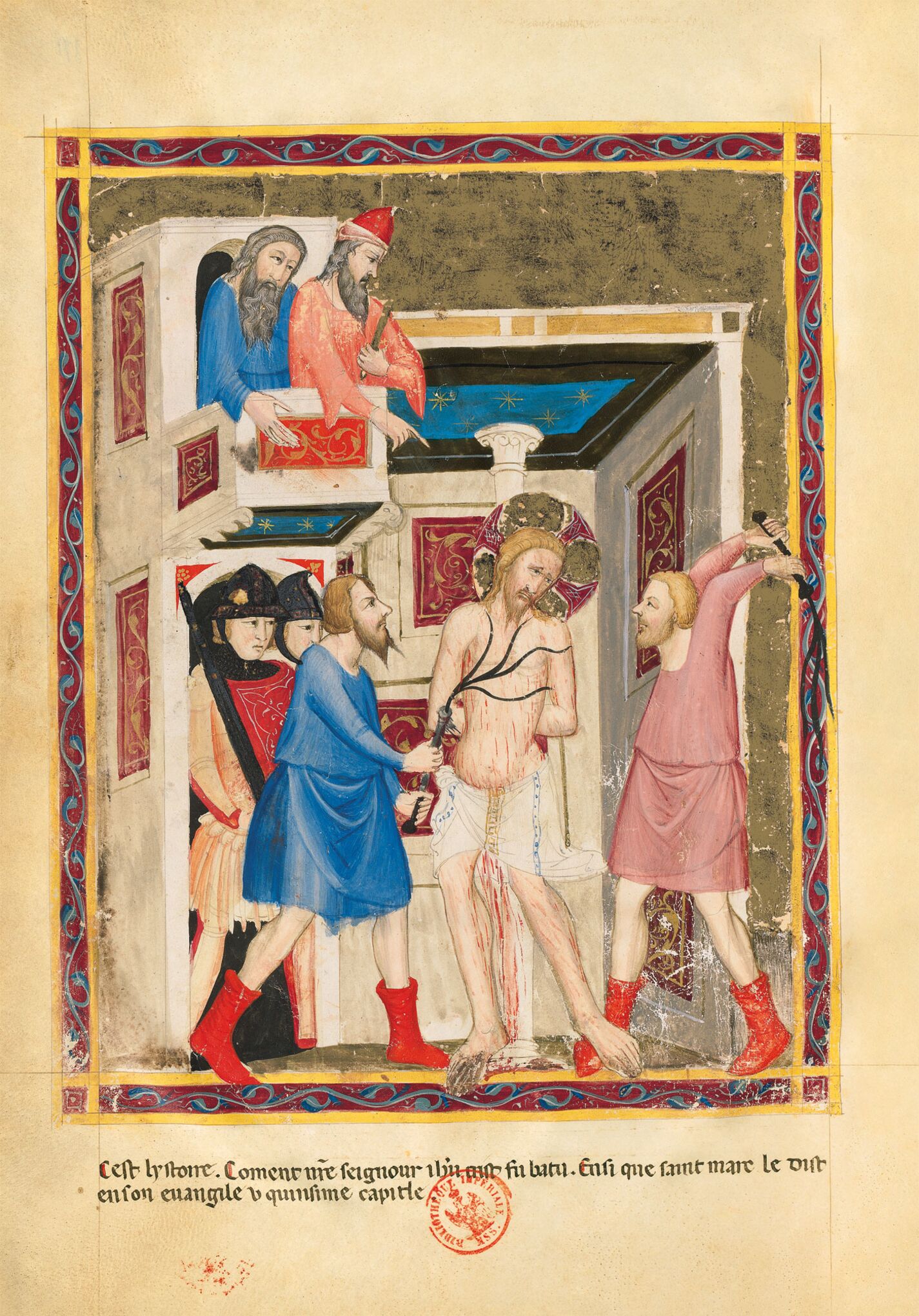“This is the story: How Our Lord Jesus Christ was scourged. Thus says Saint Mark in his Gospel in the fifteenth chapter.”
For the first time in the Bible of Naples, the paraphrase beneath the illumination of Christ’s scourging is based on the Gospel according to St Mark. But the descriptions given in the four Gospels tally: after appearing before the Sanhedrin, Jesus is taken to Pontius Pilate, the governor of the Roman province of Judea at that time. He questions Christ and, after finding no real reason for arresting him, he suggests to the people of Jerusalem that he be released for it was customary to pardon a prisoner during the Jewish Passover about to be celebrated. Meanwhile the high priests urged the crowd to demand that a rioter called Barabbas be released and that Jesus be crucified. To maintain social order, Pilate agrees to submit the Messiah to popular judgement. The miniaturist has depicted the governor on the palace balcony, sceptre in hand next to an old man with a long, grey beard who signifies the Sanhedrin. It is easy to imagine the two men in their gallery listening to the people clamouring about the fate of the prisoners but by applying a favourite device, painter A manages to squeeze several moments from the same episode into a single image. Pilate is, in fact, ordering Jesus to be scourged, a punishment that the Romans inflicted prior to crucifixion. The Ancient of the council by Pilate’s side savours his victory whilst watching Christ being scourged at the pillar. The setting is a room open for all to see, overlooked by the dignitaries’ balcony. Two soldiers with helmets and long swords stand guard at the entrance. Christ is tied by his wrists to a white column crowned by a capital featuring acanthus motifs, stretching from the floor to the ceiling. He bleeds profusely beneath the leather lashes that his torturers take turns to whip him with and his expression is one of excruciating pain. Christ is, however, a head taller than his zealous torturers, and his large gold, cruciform halo makes him look even bigger. A white perizonium is tied around his waist to protect his modesty. A man swings a whip behind his head to bring it down even more forcefully. The Messiah looks him straight in the eye, and thus begins his Passion.
Yves Christe
University of Geneva
Marianne Besseyre
Illuminated Manuscripts Research Center, Bibliothèque nationale de France
Fragment of the Bible moralisée of Naples commentary volume

“This is the story: How Our Lord Jesus Christ was scourged. Thus says Saint Mark in his Gospel in the fifteenth chapter.”
For the first time in the Bible of Naples, the paraphrase beneath the illumination of Christ’s scourging is based on the Gospel according to St Mark. But the descriptions given in the four Gospels tally: after appearing before the Sanhedrin, Jesus is taken to Pontius Pilate, the governor of the Roman province of Judea at that time. He questions Christ and, after finding no real reason for arresting him, he suggests to the people of Jerusalem that he be released for it was customary to pardon a prisoner during the Jewish Passover about to be celebrated. Meanwhile the high priests urged the crowd to demand that a rioter called Barabbas be released and that Jesus be crucified. To maintain social order, Pilate agrees to submit the Messiah to popular judgement. The miniaturist has depicted the governor on the palace balcony, sceptre in hand next to an old man with a long, grey beard who signifies the Sanhedrin. It is easy to imagine the two men in their gallery listening to the people clamouring about the fate of the prisoners but by applying a favourite device, painter A manages to squeeze several moments from the same episode into a single image. Pilate is, in fact, ordering Jesus to be scourged, a punishment that the Romans inflicted prior to crucifixion. The Ancient of the council by Pilate’s side savours his victory whilst watching Christ being scourged at the pillar. The setting is a room open for all to see, overlooked by the dignitaries’ balcony. Two soldiers with helmets and long swords stand guard at the entrance. Christ is tied by his wrists to a white column crowned by a capital featuring acanthus motifs, stretching from the floor to the ceiling. He bleeds profusely beneath the leather lashes that his torturers take turns to whip him with and his expression is one of excruciating pain. Christ is, however, a head taller than his zealous torturers, and his large gold, cruciform halo makes him look even bigger. A white perizonium is tied around his waist to protect his modesty. A man swings a whip behind his head to bring it down even more forcefully. The Messiah looks him straight in the eye, and thus begins his Passion.
Yves Christe
University of Geneva
Marianne Besseyre
Illuminated Manuscripts Research Center, Bibliothèque nationale de France
Fragment of the Bible moralisée of Naples commentary volume